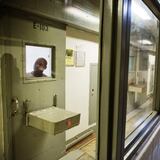The city of Atlanta is on the verge of a major new effort to clear out homeless people living under bridges, a move that officials tie to public safety after a string of fires but that raises questions about where people without homes will end up.
One option proposed: Creating a large new shelter in Georgia’s capital city.
A spokesman for the mayor said that the sweep will begin “in the coming weeks.” People involved with homeless services say they’ve been told it could start Friday or next week.
The city has declined to share most details of the operation publicly, including which specific bridge areas will be targeted, how many people it anticipates moving, and what kind of housing and locations it might provide to those displaced. Instead, “due to the sensitivity of the matter, the Administration’s priority is having a direct dialogue with community leaders and stakeholders ahead of any action taken,” spokesman Michael Smith wrote on Wednesday in an email to The Atlanta Journal-Constitution.
The chief executive of Partners for Home, the city’s lead agency responding to homelessness, also did not answer AJC questions seeking more details by deadline.
Some of those who are homeless don’t know what’s coming. They haven’t heard of a new campaign to force them to move.
Credit: Jason Getz
Credit: Jason Getz
The steps the city has weighed include “innovative” ideas, said Brad Schweers, the executive director of Intown Cares, an Atlanta-based nonprofit that focuses on homeless services and has been part of the city’s planning meetings.
One step discussed is providing cellphones to every displaced homeless person so that they could remain in touch with caseworkers who could continue to help them no matter where they end up after the bridges are cleared, Schweers said.
Another is to create a shelter with space for up to 200 people while they wait to get longer-term housing, such as in subsidized apartments, Schweers said. It would be open 24/7, allowing residents to leave and return as they please. Schweers said he doesn’t know the exact location.
Residents would stay potentially for months, face limited restrictions and be allowed to bring in more personal items than some existing shelters normally allow, he said. Unlike warming centers that the city and other local governments sometimes open in frigid weather, the shelters wouldn’t close even when temperatures are warmer. The various steps, Schweers said, could make the shelter more appealing to some people who are homeless.
But the new setting would be a departure from the city’s recent previous practices of shifting people temporarily into their own private rooms leased out in blocks from local hotels, while sometimes months-long work is done to assess their needs, get necessary identity documents and line up other government aid.
Case workers and others say some people who are homeless, many of them with mental health issues, are wary of traditional mass shelters, in part because they feel vulnerable sleeping and living in big crowds. That has sparked concerns that some people who are displaced will instead relocate to other nearby bridges, parks or other public spaces.
Meanwhile, the city is pursuing “a very condensed” time frame to move people out from under bridges, Schweers said. Typically, the city follows guidance providing caseworkers 90 days of lead time to meet with people in camps, build trust with them, assess their needs and encourage them to accept housing and maybe even move them there before police and crews come to clear them out.
Still, “it’s totally understandable that the city needs to move quickly,” given the bridge fires that have happened in the past, he said.
The city has for years known about the potentially devastating risks of bridge fires, dangers often blamed on people who are homeless.
Just before Christmas, an area near a tent site under Cheshire Bridge Road caught fire, damaging a bridge and closing the road. A similar blaze had shut down another section of Cheshire Bridge before. Parts of Buford Highway have been shut down temporarily from smoke and fires. And in 2017, flames collapsed a raised portion of I-85 in the city.
The blazes have resulted in millions of dollars in damages, worsened commute times and caused local businesses to lose money.
Credit: Jason Getz
Credit: Jason Getz
After the most recent fire that shut down part of Cheshire Bridge Road, in December, Atlanta Mayor Andre Dickens said he assembled a team to figure out the best way to close the encampments and move their residents to shelters.
Last week in an meeting with the AJC’s editorial board, Dickens said people seeking a covered place to live under bridges use fires to stay warm or cook, but those fires can become uncontrollable.
“So they cause risk to themselves from fires burning them; they cause risk to their neighbors in various tents who are living out there; and then they cause challenges for the public,” Dickens said. When such fires cause road closures, “you can’t drive to where you need to go,” he said. “It impacts schools, it impacts commerce, and it impacts people’s lives.”
He said the city’s new effort will involve “a massive set of bridge encampment closures,” including the addition of heavy-duty fencing and other obstacles to dissuade people from returning.
Dickens noted the challenges, in part because it involves property belonging to different governments and railroads. “So it’s complex, but we’re going to do it because you can’t have people unsafe.” City officials said the focus would be on 10 to 20 “priority” bridges, particularly those that are relatively low to the ground.
Smith, the mayor’s spokesman, wrote in an email this week that it “will be a compassionate operation, with a variety of services offered to our unsheltered population — including housing options, medical care and other services tailored to the unique needs of those we are serving.”
The push comes amid the city’s ongoing broader efforts to get more people out of homelessness, boosted in large part by federal dollars tied to the pandemic.
Some of that work has included clearing out people from below bridges before. In some cases, crews have added boulders to try to prevent people from returning to erect shelters and tents again.
Credit: Jason Getz
Credit: Jason Getz
But many find ways to return to the same spot or nearby ones.
On Thursday morning, Kimberly Rose Tisby, 51, was seated at the opening of her blue tent at a homeless encampment beneath a bridge over Pryor Street in downtown Atlanta. Lying next to her with his eyes closed was a man named “Hank,” whom she said was in his 70s.
She noted that “no camping” and “no trespassing signs” had appeared recently at the underpass but that she hadn’t heard about any impending effort to make her move. If she was forced out, she said she wasn’t sure where she would go next. She said she had heard about cargo containers for unhoused people near the downtown Greyhound bus station, but officials have told the AJC that space there is already spoken for.
She laughed at the notion of being given a cellphone. ”A cellphone isn’t an apartment. It’s not shelter. I don’t know who they think we’re supposed to call,” she said. Tisby, who said she suffers from bipolar disorder and schizophrenia, noted that a lot of the shelters are full.
John Jenkins, a 70-year-old, said he was homeless before he got an apartment through the city. He said in the last year and a half many others have gone into housing after being moved out from the Spring Street underpass, which he sometimes still visits. He said he urges people still on the streets to accept housing assistance.
Nearby, a man arranged his belongings and comforters on the sidewalk where he sleeps below Williams Street ramps. Among the man’s meager possessions were two brooms, which he used to sweep the concrete and pavement nearest him.
“Everybody deserves a chance,” Jenkins said. “They got all these empty buildings. Why not help people?”







